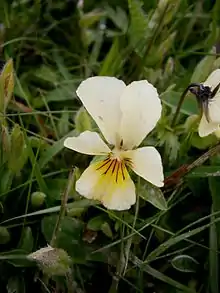Viola lutea
Viola lutea, also known as the mountain pansy,[1] is a species of violet that grows in Europe, from the British Isles to the Balkans.
| Mountain pansy | |
|---|---|
 | |
| Scientific classification | |
| Kingdom: | Plantae |
| Clade: | Tracheophytes |
| Clade: | Angiosperms |
| Clade: | Eudicots |
| Clade: | Rosids |
| Order: | Malpighiales |
| Family: | Violaceae |
| Genus: | Viola |
| Species: | V. lutea |
| Binomial name | |
| Viola lutea | |
Description
Viola lutea grows to a height of around 20 centimetres (8 in). Its flowers are 20–35 mm (0.8–1.4 in) in diameter, and are typically yellow, although some individuals may have blue, purple or blotched flowers instead.[2]
Taxonomy
Viola lutea was first described by William Hudson in his 1762 Flora Anglica.[3]
V. lutea subsp. lutea is native to central and north-western Europe, from the British Isles to Austria; another subspecies occurs further east, from Hungary to the Balkans.[4]
Two very special subspecies are V. lutea subsp. calaminaria which occurs in the southernmost Netherlands and eastern Belgium, and V. lutea subsp. westfalica, which only occurs at an extremely small locality near Blankenrode in East Westphalia, Germany. Both taxa have relatively recently evolved to take advantage of the local pollution left over after centuries of mining for metals in these locations. The subspecies calaminaria grows in areas where the mine tailings for zinc ore have been dumped, and the subspecies westfalica grows on heaps of lead ore waste. Both taxa have managed to become the dominant plant species in their extremely small habitats.[5]
Distribution
Within Great Britain, Viola lutea is found only in upland areas north of a line drawn between the Severn and Humber estuaries; it ranges in altitude from 200 metres (660 ft) in Derbyshire to 1,070 m (3,500 ft) in Breadalbane.[4] In Ireland, its distribution is more scattered geographically, and ranges vertically from sea level in County Clare to 380 m (1,250 ft) in the Wicklow Mountains.[4]
Uses
Viola lutea is the main progenitor for the common cultivated garden pansy, V. × wittrockiana. This hybrid was created by gardeners in Britain in the early 19th century.
References
- "BSBI List 2007". Botanical Society of Britain and Ireland. Archived from the original (xls) on 2015-01-25. Retrieved 2014-10-17.
- Clive A. Stace (2011). "Viola L. – violets". New Flora of the British Isles (3rd ed.). Cambridge University Press. pp. 332–335. ISBN 978-0-521-70772-5.
- William Hudson (1762). "Viola". Flora Anglica. London: published by the author. pp. 330–332.
- O. E. Balme (1954). "Viola Lutea Huds". Journal of Ecology. 42 (1): 234–240. JSTOR 2256996.
- Hildebrandt, Ulrich; Hoef-Emden, K.; Backhausen, S.; Bothe, Hermann; Bożek, M.; Siuta, A.; Kuta, Elzbieta (March 2006). "The rare, endemic zinc violets of Central Europe originate from Viola lutea Huds". Plant Systematics and Evolution. 257 (3): 205–222. doi:10.1007/s00606-005-0387-4. Retrieved 26 October 2020.
External links
- "Viola lutea (Mountain Pansy)". Online Atlas of the British and Irish Flora. Biological Records Centre.
 Media related to Viola lutea at Wikimedia Commons
Media related to Viola lutea at Wikimedia Commons